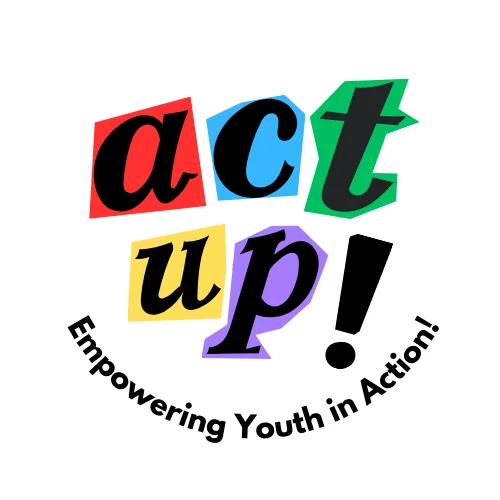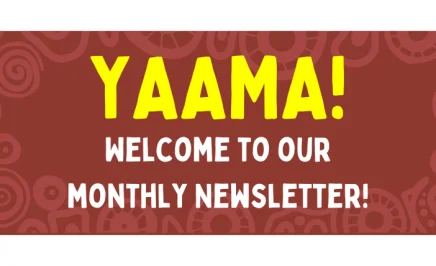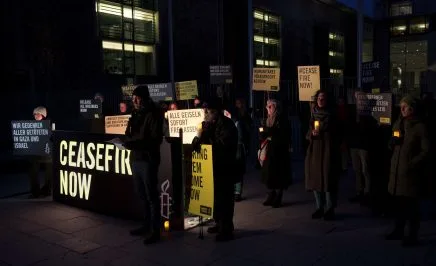Edition 3 | August 2024

Hey fellow activists!
The creators of this edition would like to acknowledge the traditional protectors and custodians of the land on which we write, Amnesty International Australia operates, and you reside. We pay our respect to elders past, present, and emerging, recognising their resistance in order to preserve their ongoing stewardship of the land.
Happy International Youth Day and Welcome to this edition of Act Up! on ‘Art as a form of Resistance’.

At first glance, the word ‘resistance’ evokes imagery of physically conflict. Of a soldier sacrificing for their nation, or citizens refusing to accept oppressive leadership. Resistance has been widely portrayed as an action. Discussions of forms of resistance emphasise how orators preach widely-received messages, or partisans fight through blood, sweat, and tears. But what if I told you they weren’t the only forms of resistance? This issue will take you on a journey through different forms of resistance; from art and poetry to music and graffiti, exploring how they shape our world.
Songs, musical instruments, dance, drawings, paintings, and every single art you can think of ALL of them have been used to show resistance against the occupation of one’s country or against the tyranny from their regime that they are suffering under. The people whose voices could not be heard, the people who had no courage, strength or motivation to actively show the world their part in the fight for their human rights, those people scared but angry show their resistance, show their brothers and sisters, that they care and that they are fighting, through the countless forms of art. Tokyo Rose is the greatest example of this, a woman who used the radio to her advantage.
Tokyo Rose, also known as Orphan Ann (her real name being Iva Toguri) was an American citizen born to immigrant Japanese parents. In 1941 she moved to Japan to take care of her ill aunt but soon the infamous bombing of Pearl Harbor in December of that year and Iva was forced to stay in Japan and become a radio girl and typist for Radio Tokyo, or how the allied forces liked to call them “Tokyo Rose”. That name was given to every woman on the radio of Japan who were forced to spread propaganda about the allied forces to all those listening and coerce them to desert the army and discourage US army soldiers. However, she did the COMPLETE OPPOSITE! Their script, which was in English, could not be understood by other Japanese and due to cultural misunderstandings Tokyo Rose was able to get away with treason – essentially – when she instead encouraged US soldiers to fight and up-lift their spirits with jokes or funny music of their time. Many saw her as a soldier who was fighting for the United States behind enemy lines. She was arrested for treason by the US Army authorities after the war ended and pardoned in 1977, 27 years after being arrested.
We are excited to share more ways art has been used as a form of resistance throughout this edition! Again please, let us know if you have an idea for the newsletter or want to add something to it to share with others. As you are all Youth Members, this newsletter is for you, so please get involved in whatever way you’d like. If you have a question, feedback, general inquiry, send us a message through the form below!
We hope you enjoy this edition! We look forward to hearing from you all!
In Solidarity,
Your Working Group


Learn about what other young people are up to, what they have to say and what they care about in the Amnesty Movement!
Graffiti as a form of Resistance: A non-violent and equally strong alternative to defiance
Written by Akanksha Kasha (Amnesty Youth Member)
Remember the images of war-torn countries, bombed cities and destroyed neighbourhood’s popping in the news, on social media, or just a google search away? Though sources wary one thing remains consistent, the images of broken buildings always, every single time, have bold, colourful, and angry graffiti all over them. That street art done by mysterious people is a form of resistance for the one’s whose voices were not being heard.

For centuries every ancient city plagued with oppression or war have been subjected to the wrath of street artists who often made it their life’s mission to spread their words, the most powerful resource in a fight, across every wall, every building, in hopes that others see it and they too join the resistance or simply change people’s minds.
Graffiti can be taken back to when humans first learnt how to draw using clay or rocks. In ancient Egypt, the buildings hold the words of the dead, who back then found the bravery to etch on the walls their – and many others – opinions on the current reigning Pharaoh and all his terrible acts.
During the peasant’s crusades from April to October in 1096, to the other crusades before and after, in medieval England the many peasants and knights left their mark on the towns they passed on their march with engravings on stone houses of the religion they preach – Christianity. The crusades were a time when the Christian people believed that the great city of Constantinople (now Jerusalem) belonged them and they set off on a centuries long march to seize the place for themselves. On the way, they pillaged and looted towns from their own regions and leave behind the bearings of their unwavering faith.

These engravings of crosses on walls of Jerusalem is evidence of the resistance the Christians of the time had against the Muslim’s occupying what they believed as rightfully theirs. These arts not only left as evidence of the people’s beliefs but also screamed to all that lay eyes on the walls of Jerusalem that it was theirs.
And now, in modern days, graffiti can be found anywhere, and most prominently in the countries that are experiencing war and bloodshed as we speak. Graffiti gives a voice for the people who want to be heard, its helps increase resistance against a cause and most importantly its shows the world that people are still fighting, even without showing it.
Songs of Resistance: How Music Shapes our Society
Written by Thomas Coorey (Amnesty Youth Member)
Less contact between the rich and poor.
Less political participation.
More fear.
These are a few of the observations offered by the rock ‘n’ roll group Radiohead in 2017. Some might call it a media stunt – they preceded the rerelease of their 1997 album OK Computer. But this would ignore the rest of the album. Its lyrics discuss rampant consumerism, alienation from society, and a creeping political melancholy. They hold a torch up to society, illuminating its flaws; not allowing truth to be obscured in shadows of ignorance.
That’s the power of music – it can criticise and applaud; it can define aspirations or negotiate challenges; it can protest and rebel against oppression. Music has a unique ability to transform people, perspectives, and society.
Just take the song ‘We Shall Overcome’. It emerged in its modern form from African American communities in the 1940s as a rallying cry; a promise to continue striving towards equality. Since then, it’s been sung as an anthem of resistance and solidarity. By labour movements striking for better wages. By civil rights activists mourning Martin Luther King Jr. By Czechoslovakian protesters challenging Soviet oppression. This song has inspired millions around the world fighting against injustice.
But what is it that makes music such an effective tool of protest? It could be a number of things. First and foremost is its undeniable ability to express. All music – even the most inoffensive of nursery rhymes – offers some sort of emotion to cling on to, whether that be righteous passion or a calm sense of security.
Second comes the ability to say what cannot be written. Music can express and communicate without the use of language – a quality especially important in societies that place restrictions on speech. For example, Russian composer Dmitri Shostakovich used his symphonies to criticise Joseph Stalin’s regime and its censorship. In a nation that erected barriers against words, music could break through!
The third is that people like music. It sounds obvious, but the popularity of music can be used to rally people to a cause. Music can bring broader attention to social issues – Taylor Swift’s ‘You Need to Calm Down’ addressed pervasive homophobia and anti-LGBTQ+ attitudes. Whilst criticisms were levelled that the song was performative and cynical, it undeniably increased support for LGBTQ+ rights, seen through the 704 000 signatures on a petition Swift started in support for the Equality Act, which would ban discrimination based on sexuality or gender identity. Undeniably, music can transform the world.
Music clearly has a special power to inspire and create change. It’s a form of resistance uniquely suited to cut through background noise and force an issue to the fore. So next time you play a song, have a think about what it means.
It might just be trying to tell you something.
Street Art for a Healthy Future
Written by Alyssa Coleman (Amnesty Youth Activist)
Fruit and veggies. A daily source of nutrient that in Australia, most of us are lucky enough to have as an accessible means to live a healthy life.
However, in the Pacific Islands irresponsible consumption and production is on the rise, with a declining accessibility to locally grown, healthy food. Due to the implications of Climate Change upon the islands, in conjunction with the global economic impacts, a continuing rise in processed and unhealthy food at a cheap, affordable rate has been seen. Following on from this, impacts include, a significantly disproportionate a rise of diabetes and food security issues becoming prominent.
To highlight this systemic issue Tasty Kitchen Collective (a non-profit organisation), was established in Fiji, as a means of creating awareness for communities and establishing the phrase “think local, eat local.” To encourage holistic thinking and joining with Graffiti Camp for Girls to promote gender equality, Street Art for a Healthy Future was created! Revisioning resistance with bright and creative artwork of fruits and vegetables, creating one of the biggest street murals found in Suva.
In some of the most unsuspecting ways, fruit and vegetables and graffiti artwork acted as a means of resistance for poverty and gender inequality, raises awareness for good health and well-being, zero hunger and responsible consumption/production.


Art of Resistance for Gaza: The Intifada
Written by Asha Burr (Interim YAG Rep, Youth Member and guest member of the NSW ALC)
The movement fighting for the end of genocide in Gaza has been a call of concern globally, as the rise of the intifada has inspired a form of resistance empowered by the artwork created by the Palestinian community and other artists. Art is a powerful tool to ignite ideas and emotions for a cause, especially grabbing the attention of the youth in our society to spread the importance of what happens in our world today. It has been used as a form of protest, an emotional outlet, a call for change and a way for Palestinians to preserve their identity to prevent the erasure of a culture, a community, and a home.
Many artists have used their work to demand justice and freedom, to end the bloodshed and genocide in Israeli-occupied Palestine. Art has become a voice for the Palestinians to call for help and express their distraught over the ethnic cleansing and genocide of their people.

This is something I have personally witnessed at Pro-Palestinian protests where the artwork has successfully inspired a reaction. Images and posters that convey an understanding of the suffering of the Palestinian people and their homes. One poster that had caught my eye, displayed various faces of children who had been murdered throughout this mass destruction. I allowed the artwork to swallow my attention and took in all the young faces, confronted with such horror. Next to the poster was a young girl with her father, sitting on his shoulders. Watching these two side by side was incredibly revelatory, reminding me of the privilege of living in Australia.

Art has been used to show solidarity and support with the Palestinians as this poster above did. It strives to pull a sense of sympathy and understanding through expressive colours and symbols of the movement (e.g. watermelons or colours such as red or green). Cartoons, poetry, and music are different forms of art that were powerful tools in the movement. During the protest above, waving in the air, was an artwork of a cartoon drawing of Joe Biden, Anthony Albanese and Benjamin Netanyahu in a comical form to mock their complacency in this ongoing genocide within their governments through funding and actively contributing to the oppression of the Palestinians.
For centuries, art has been used to create revolutionary cultural impacts, one of the most famously known influences was during the Renaissance movements and the art in this period that ignited awareness and sparked ideas that can be seen today within the intifada for Gaza. Historically, since the start of Nakba (the dispossession of land and ethnic cleansing of Palestinians) in 1948, art has been used as a form of resistance against the Israeli occupation, a form of storytelling about the experience.
Unfortunately, with the rise of Palestinian artwork, came a rise in censorship. This is seen in the case of Janin Yaseen with her artwork being banned at the local arts museum. She stated what she strived for her art to achieve, “It is about being a voice for those who are voiceless”. Art is a voice through a resistance of silence, a representation of the oppression of a population and the destruction of a culture.

I like to remember that “Art should comfort the disturbed and disturb the comfortable” – Cesar A. Cruz. To be confronted by powerful artworks displaying the Palestinian experience would make viewers shuffle in their seats and feel uncomfortable, peeking into the eyes of the people going through 75 years of oppression under the Israeli government. Palestinian art is used as a message to the outside world to call upon the international community and nation-states to act on the ongoing violence and demolition received by many generations.
Palestinian artist Laila Ajjawi’s work is used to reflect on her experience in a Palestinian refugee camp and her time growing up there living in those conditions. Her work has had an impact globally, inspiring other artists to use their gift to express their emotions on the war on Gaza.
Art is the language of the world. Art as activism is a key component of the movement for Palestinian liberation as it communicates the struggles experienced by the Palestinians to a multi-national audience. No matter whether you are Palestinian or not, we all feel the impact of this art in one way or another. Art communicates more than words can at times. Artwork calls for collective action for the Palestinian cause.

Find out what’s happening soon at Amnesty!
✍️ Attend the Writing for Activism Workshop in Sydney!
Saturday, 17th August @ 12:30pm at Amnesty’s Gadigal Action Centre
Do you want your writing to have an impact? Do you want it to challenge injustice? Then join us at Amnesty’s Gadigal Action Centre for a fantastic Writing for Activism Workshop run by the Sweatshop Literacy Movement.
Join your local Amnesty Action Group to get more involved with activism on the ground!
We have just re-vamped our Action Group webpage to make it easier to navigate! Click to the button to find your local group and sign up to let them know you’d like to get involved or hear about their events and activities!
Stay updated on upcoming events happening near you!
While you’re waiting for the next edition of the Act Up! newsletter to find out about Upcoming Opportunities, why not check out our new and improved Events Page on our website to stay even more up-to-date!

What else can you expect from the Act Up! newsletter?
As a Working Group, we are committed to publishing an edition of Act Up! once a month.
Going forward, here is what you can expect from this newsletter:
- Sharing any UPCOMING OPPORTUNITIES for fun & exciting things that are happening in the movement (i.e. Youth Action spaces, campaign events, rallies/protests, training workshops, Members Forums etc.)!
- YOUTH ACTIVIST SPOTLIGHTS where we will highlight the personal activism stories of youth activists in our movement. Every story is important and valuable so get in touch if you want to share your story!
- Sharing what young people are doing within Amnesty, in their local communities, schools, universities or at Amnesty events in our YOUTH ON THE MOVE section! Get in touch if you have been doing some cool things!
- GET IN CONTACT via the form below to have your say, share your piece or even join our working group!
We want YOU to get involved and share your experiences, stories and creative works in the human rights activism and advocacy space through the Act Up! Youth Newsletter.
Thank you for being comfortable and confident enough to share what you and your community are doing for human rights. See you next month with our next edition!




